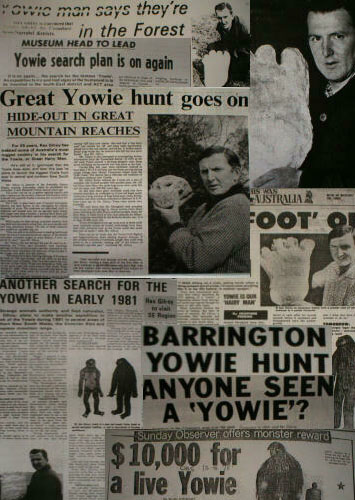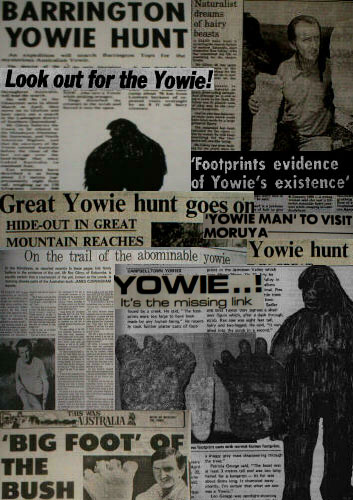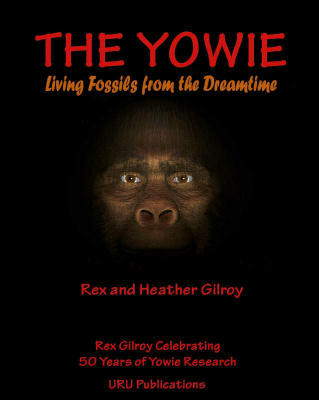Homo erectus in Australia - Part2
This article is composed of extracts from the 2007 book:
“The Yowie Mystery - Living Fossils From The Dreamtime".Copyright (c) 2007 Rex Gilroy, Uru Publications.
On Wednesday 23rd May 1972, my late father, Mr W.F. [Bill] Gilroy, an old gold miner, was fossicking in the Fish River outside Tarana, just west of the Blue Mountains, when near the base of old Pleistocene bank deposits of a former course of the river, he came across the limestone endocast of a large hominid skull.
When he brought the fossil to me at my then Mt York Natural History Museum, at Mt Victoria that afternoon I was overjoyed, for up until now the only hominid fossil evidence in my collection was a 52mm tall mineralised giant hominid fossil lower back premolar tooth.
The fossil was distorted, the braincase being flattened at the rear and most of the lower jaw was represented joined to the upper jaw. The right side of the skull endocast had been pushed inwards, crushing the right brow ridge. This had been due to the usual geological pressure upon the skull while moistened to a soft state after being buried deep beneath the ancient deposits from which it had only recently been dislodged.
I measured the fossil at 25cm in length across the dome; 19cm wide and 18cm deep. Allowing for its distorted appearance a reconstruction of the fossil revealed the following: The general formation of the endocast suggested to me a more modern rather than primitive hominid. For example, the skull displayed a receding forehead but no thick projecting eyebrow ridges as would be expected in a Homo erectus skull. The shape of the endocast was undoubtedly brachiocephalic [ie rounded] rather than doliocephalic [ie long, narrow] and this was significant for it placed this skull-type within the genus Homo, but not with erectus, rather it was an example of an ‘archaic’ Homo sapien.
A year after this discovery, on April 14th 1973, my father and I returned to the site. While exploring along the river’s edge, beside the base gravels of the same bank from where the previous skull had been recovered, I picked up a second, though smaller limestone skull endocast, barely 33.3m from the situation of the previous find. Excited at my discovery, I showed my find to dad before carrying out measurements of the old Pleistocene bank stratas from which the skulls had been dislodged.
The latest skull displayed distinct differences to those of the first, which I now described as Skull No 1. for one thing, although the rear of the braincase was missing and it had suffered distortion which had flattened the right side of the specimen outwards, there were two projecting brow ridges and eye sockets present together with a receding forehead. Reconstruction of the specimen carried out later on paper showed that, had the skull been intact, it would have been doliocephalic in shape and that of a ‘late’ form of Homo erectus.
The specimen measured 16cm across the dome, by 14cm wide and approximately 9cm deep. As Skull No 2, came from the same bed as Skull No 1, it was obvious that they were of the same age. The old bank stratas were 3m deep and these fossils came from the base deposit, being the situation of a former campsite. These limestone endocasts were at least 200,000 years old, with much older bank deposits above them which were dated at up to 150,000 years BP.
This suggested that, around 300,000-350,000 year ago, two hominid populations alternatively shared the same campsite on the edge of the Fish River, one of these a population of ‘late’ Homo erectus, the other his offshoot, ‘archaic’ Homo sapiens. It was obvious to me that both populations would have been widespread throughout the central west and as later finds would show, on the Blue Mountains. The evidence suggests that, by no later than around 300,000 years BP, anatomically modern humans were present in Australia, prior to their alleged ‘first’ appearance in Africa barely 200,000 years ago!Photograph right: Aboriginal Girl wearing a Kangaroo hide Garment. Photographer Unknown. I will credit anyone who owns this photograph.
The Australian Aborigines, or Australoids, had reached this continent from island south-east Asia some time prior to 65,000 years ago. They settled here in time to see the last of the megafauna, and also other, earlier human inhabitants which they subsequently began killing off and driving them out of any region the Aborigines occupied. The more remote wilderness-covered mountain ranges offered an escape to many groups of Homo erectus; his offshoot, Homo sapiens; pygmy and giant Homo alike; As time wore on the Aboriginal population grew to dominate the land, while their folklore evolved around the ‘evil spirits’, malevolent “little people”, cannibal beings both giant-size and otherwise that inhabited the wilderness regions.
All became generally known as “hairy people”, “little hairy people” and “hairy giants” because like the Aborigines they were said to wear kangaroo and other fur cloaks. Thus the myths and legends of these beings grew, becoming collectively merged as the “hairy man” or Yowie. As I have already stated in this book, there was/is more than one form of the so-called Yowie. All have a [fossil] basis in fact as this chapter, and others to follow will demonstrate. The Australian Aborigines, or Australoids, had reached this continent from island south-east Asia some time prior to 65,000 years ago. They settled here in time to see the last of the megafauna, and also other, earlier human inhabitants which they subsequently began killing off and driving them out of any region the Aborigines occupied.
The more remote wilderness-covered mountain ranges offered an escape to many groups of Homo erectus; his offshoot, Homo sapiens; pygmy and giant Homo alike; As time wore on the Aboriginal population grew to dominate the land, while their folklore evolved around the ‘evil spirits’, malevolent “little people”, cannibal beings both giant-size and otherwise that inhabited the wilderness regions. All became generally known as “hairy people”, “little hairy people” and “hairy giants” because like the Aborigines they were said to wear kangaroo and other fur cloaks. Thus the myths and legends of these beings grew, becoming collectively merged as the “hairy man” or Yowie.
As I have already stated in this book, there was/is more than one form of the so-called Yowie. All have a [fossil] basis in fact as this chapter, and others to follow will demonstrate. So far we have only mentioned giant hominids and pygmy forms of the Australian bush in passing. These races and their fossil skull-types and other evidence is about to be dealt with in full in the following chapters, as we continue to reveal the various forms of the ‘hairy man’.
There was a time when all we had to show for evidence of former giant races in Australia, was a single giant hominid molar tooth and a few fossil giant-size footprints, as well as a number of ‘megatools’ from the Bathurst, New South Wales district. All this has changed in the last several years with the discovery of the Coolah, New South Wales skull and jaw fragments, the two massive skull endocasts from the New South Wales far south coast and other important evidence about to be presented.
The pygmy evidence has also grown. Whereas for many years all we had to go on were old Aboriginal traditions, we are now in possession of fossil skull-types and other archaeological evidence of these mysterious little people. The evidence presented in this book we believe, shows that Australia possesses a truly unique array of historical material, making it a ‘treasure house’ of fossil human beginnings, as well as evidence of the continued existence of relict beings from our ‘unknown’ Stone-Age past, awaiting the attention of the sensible investigator.
“The Yowie Mystery - Living Fossils From The Dreamtime".
“The Yowie Mystery - Living Fossils From The Dreamtime". Special Dedication. The Authors dedicate this book to the late Charles Melbourne Ward F.Z.S.; F.R.Z.S. known to his great many friends simply as ‘Mel’. Together with his wife Halley, he operated a natural history museum in the grounds of the Hydro Majestic Hotel at Medlow Bath for many years and also another established at Echo Point, Katoomba. It was ‘Mel’ who first taught me how to collect, record and study natural history specimens, beginning when I was aged 11 years old on holidays with my parents at Katoomba in 1954. Thereafter, every school holidays spent in Katoomba began with a visit to ‘Mel’ at his Medlow Bath Museum to inform him how my fledgling natural science studies were progressing!
As a result and after my parents moved from our Lansvale [western Sydney] home to Katoomba, the Gilroys and Wards became close friends. There was hardly a week which did not see me peddling my pushbike from our North Katoomba home up the Great Western Highway to see ‘Mel’ at his museum for more instruction. Mel Ward possessed a wide knowledge of the culture of the Australian Aborigines and that of the former local Blue Mountains tribes in particular.
He was also a firm believer in the “Hairy Man” and supported my researches in this regard. At my 21st birthday party, held at the Homesdale Function Centre, at Katoomba on Saturday night 8th November 1964, I well recall how my old friend, in front of a large gathering, congratulated me on my researches and the large natural science collection that I was forming and then said: “You’ve done a fantastic job Rex, BUT IT’S ABOUT TIME THAT YOU STARTED MAKING SOME BLOODY MONEY OUT OF IT” in a loud voice that brought the house down!
That following week, together with my father Mr W.F. [Bill] Gilroy, I began a search of local venues, which soon resulted in the acquisition of the lease from the Blue Mountains City Council of the Mt York Tea Rooms, outside Mt Victoria, the rest they as “is history”. Two years late, on October 6th 1966, Mel Ward was dead, having passed away in his sleep. He once said to my father that I was “the Mel Ward of Tomorrow” and I am certain that Mel would be pleased to know that I have indeed followed in his footsteps.
Mel led an adventurous life. The son of Hugh J. Ward, a famous Shakespearean actor of the early 20th century, Mel was encouraged to go on the stage by his father but Mel developed a passion for the natural sciences and his wealthy parents helped him become established. In his lifetime of achievement, Mel became recognised as a world authority on Crustaceans and an anthropologist. He was made a Fellow of the Royal Zoological Society of New South Wales and was pleased when I too became a member of the Society in 1963. He encouraged me, not long before his death, to take on the Presidency of the Society’s Entomological section, where I served for three years from 1966 to 1969.
That he achieved so many things in the course of his lifetime researches is remarkable, because like this author, he was an amateur with not one university degree to his name! I am certain that my old friend would be delighted at the fact that, together with heather, I am now writing and publishing book on the subjects he loved and on the Yowie in particular. He taught me never to blindly follow the textbook and dare to question dogmas and not be told what to think! I have certainly followed his advice. Knowing Mel Ward as I did I know he would wholeheartedly approve of the scientific approach of this book, therefore “Mel”
This Book is for You!
Rex Gilroy - Australian Yowie Research Centre, Katoomba, NSW.
Monday 25th June 2007I also present sensible advice to any future would-be Yowie investigators. The reader will also be awed at the great many discoveries my wife Heather and I have made in all our years together in the field. I feel privileged to be the founder of Yowie research and to have encouraged other, sensible researchers to follow my example. The search for surviving relict hominids in remote, hidden regions of the world, has been called the “last great search”, and it is both a fascinating and exciting one. Rex Gilroy may be contacted at the Australalian Yowie Research Centre, PO Box 202, Katoomba. NSW 2780. Ph 02 4782 3441 or email New Email Address as of June 2009 randhgilroy44@bigpond.com on or visit our website : http://www.mysteriousaustralia.com/ or http://www.australianyowieresearchcentre.com/ or http://www.rexgilroy.com/
Newspaper Articles on Rex Gilroy's Lifetime Search for the Australian Yowie
Newspaper Articles on Rex Gilroy's Lifetime Search for the Australian Yowie
Aboriginal/Koori Names for the Australian Yowie
To present the Yowie mystery in its proper context, relict hominid evidence from south-east Asia, New Guinea, other west Pacific Islands and New Zealand is revealed, demonstrating how the ancestors of these ‘manimals’ once spread out across the earth via land-bridges that formerly joined Australia/New Guinea/New Zealand with what is now island south-east Asia to the Asian mainland.
“Hairy man” was a name given by the Aborigines to any non-Aboriginal race with which they shared this continent, but the term centred primarily upon at least three basic forms. These forms were either the height of an average human being, an enormous man-like and also ape-like form. All were known by different names Australia-wide, but all meant either “hairy man” or “great hairy man”.
![Mr W.F. [Bill] Gilroy Holding Skull](images/skulls/wfgilroy1.jpg)





